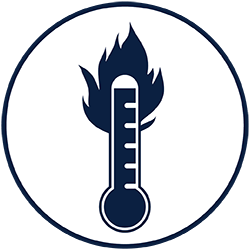Dangerous Heat

What to do during Extreme Heat
- Drink plenty of water even if you do not feel thirsty.
- Persons who have epilepsy or heart, kidney, or liver disease, are on fluid-restricted diets, or have a problem with fluid retention should consult a doctor before increasing liquid intake.
- Avoid drinks with caffeine.
- Limit intake of alcoholic beverages.
- NEVER leave children or pets alone in closed vehicles.
- Check on your pets frequently to ensure that they are not suffering from the heat.
- Avoid strenuous work during the warmest part of the day. Use a buddy system when working in extreme heat, and take frequent breaks.
- Dress in loose-fitting, lightweight, and light-colored clothes that cover as much skin as possible. Avoid dark colors because they absorb the sun’s rays.
- Protect face and head by wearing sunblock and a wide-brimmed hat.
- Postpone outdoor games and activities.
- Stay indoors as much as possible and limit exposure to the sun.
- Eat well-balanced, light, and regular meals.
- Avoid using salt tablets unless directed to do so by a physician.
- Avoid extreme temperature changes.
- Circulating air can cool the body by increasing the perspiration rate of evaporation.
Terms to Know
- Heat Wave – Prolonged period of excessive heat, often combined with excessive humidity.
- Excessive Heat Warning – An Excessive Heat Warning is issued for extremely dangerous heat conditions. The general rule of thumb for this warning is when the maximum heat index temperature is expected to be 105° or higher for at least 2 days and night time air temperatures will not drop below 75°. Heat Index values are forecast to meet or exceed daytime highs=105-110° Fahrenheit.
- Heat Cramps – Muscular pains and spasms due to heavy exertion. Although heat cramps are the least severe, they are often the first signal that the body is having trouble with the heat.
- Heat Exhaustion – Typically occurs when people exercise heavily or work in a hot, humid place where body fluids are lost through heavy sweating. Blood flow to the skin increases, causing blood flow to decrease to the vital organs. This results in a form of mild shock. If not treated, the victim’s condition will worsen. Body temperature will keep rising and the victim may suffer heatstroke.
- Heat or Sun Stroke – A life-threatening condition. The victim’s temperature control system, which produces sweating to cool the body, stops working. The body temperature can rise so high that brain damage and death may result if the body is not cooled quickly.
Hot Car Safety
70 degrees is too hot to leave a dog or child in a car.
| Temperature Outside | Temperature in Car |
|---|---|
| 75º | 118º |
| 77º | 123º |
| 81º | 138º |
| 90º | 143º |
| 94º | 145º |
Dangerous Heat – Printable Page
Last updated: 2/2/2021
